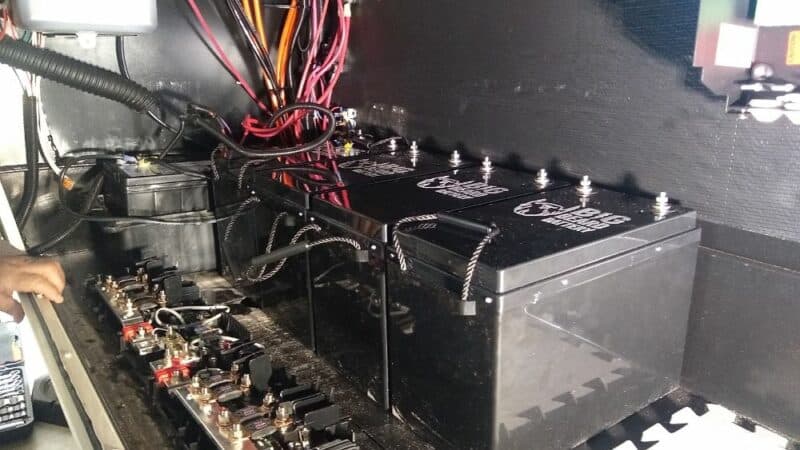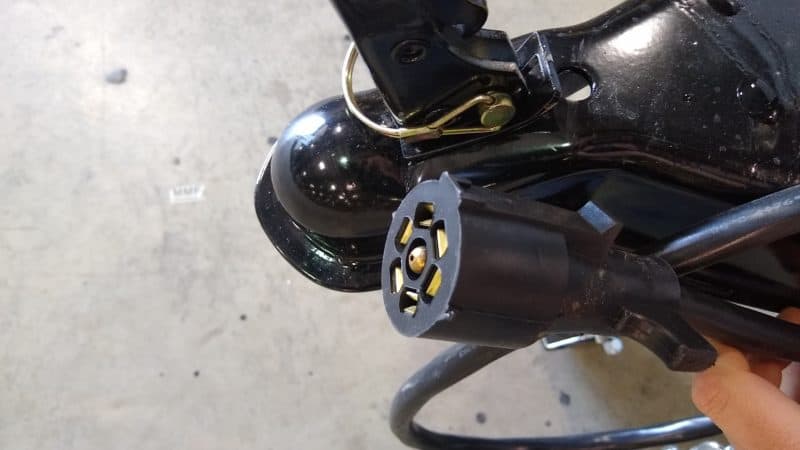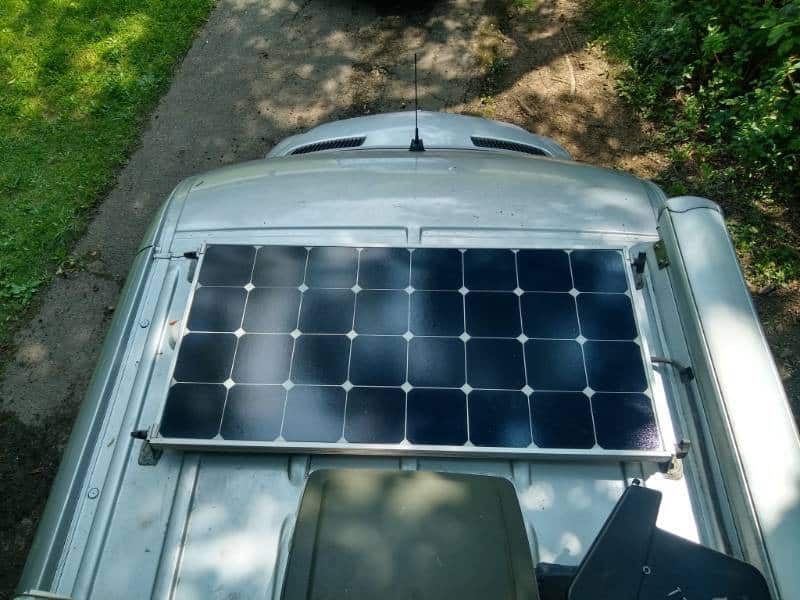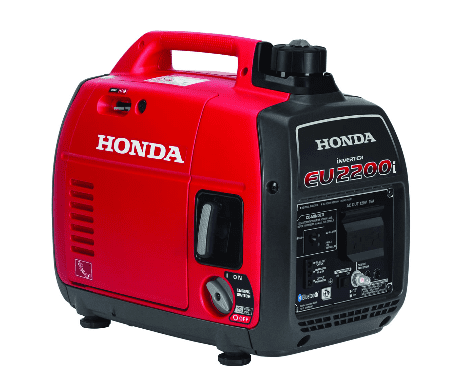So, Reader, you’ve heard the evidence from Part 1: What Are My RV Power Needs?
And the verdict is clear: You need more power! You need more RV battery life!
But how? …
You can A) generate more power or B) consume less power. Either way, you’re tipping the scales.
If I shared every possible technique for generating or saving power, we’d be sitting here until next Tuesday. But I do want you to shake hands with 6 basic strategies for making your RV battery life stretch further.
1. Upsize Your RV Battery Bank
If you’re serious about dry camping, you need an upgraded battery bank. A single battery just won’t cut it.
Most off-grid campers have 200-400 Ah of battery bank capacity.

Why not 600Ah, you ask? Simply put, it’s expensive – and heavy! If a single 100Ah battery weighs 65 lbs, then a 400Ah battery bank is 260 lbs!
If you use more than two batteries, you usually have to relocate them from the trailer tongue to the RV basement or another compartment sealed off from the interior. Otherwise, you’ll max out the tongue weight.
Don’t just store lead-acid batteries inside an RV! That’s risking an explosion! Lead-acid batteries must be sealed to the interior and vented to the outside.
The easiest upgrade is to purchase one or more 12V deep-cycle batteries and wire them in parallel with your existing battery.
Some RVers prefer to use 6V golf cart batteries wired in series. This solution will significantly improve the lifespan of your batteries, but you won’t get extra energy capacity.
While some RV owners still use flooded lead-acid batteries, most prefer AGM batteries, which can be mounted in almost any orientation and don’t require periodic maintenance.

2. Upgrade to Lithium Batteries for Longer RV Battery Life
Here’s what you need to know: You can’t discharge a battery all the way to empty. Well, you can, but you’ll only do it once!
Most deep-cycle lead-acid batteries can be safely discharged to 50% of capacity. Any more than that, and you’ll drastically shorten their lifespan.
Diehard campers will splurge on lithium phosphate (LiFePO4) batteries, which can be discharged to 10-20% of capacity! It’s like two batteries for the price of one!
Unfortunately, that “one” price is $500 to $1,000 for a single 100Ah lithium battery.
And you’ll probably have to replace your converter because lithium batteries require special chargers.
However, lithium batteries offer many benefits:
- High energy density = more batteries in smaller space.
- Low self-discharge rate = longer time unattended in storage.
- No flooded cells = almost no maintenance!
3. Charge Your Batteries Through Your Tow Vehicle Wire Connector
Actually, for most RVs, this is an awful idea. I wrote it down only because it’s a persistent myth that just won’t die.
The theory goes like this: Run a wire from your tow vehicle alternator to your 7-pin connector to your RV house battery. Your alternator *should* then charge your trailer battery, same as it charges your car starting battery.
This doesn’t always play out in reality.

TL;Dr: Most tow vehicles only trickle charge an RV battery – that means they’re super slow – so this isn’t a reasonable solution for a weekend at a campground.
- Alternators are become “weaker.” Not every alternator puts out enough voltage to charge your trailer battery! This is especially true if you’re using AGM batteries, which require a higher absorption voltage. Also, alternators are getting smaller, especially on passenger vehicles.
- Wires “lose” voltage. The longer and thinner the wire, the more voltage is lost. Dirty connections also lose voltage. Even if your alternator can push out 14.5V, by the time it reaches your battery, it might be down to just 12V. That’s barely enough to trickle charge!
Psst … If you’re new to RVs and aren’t sure what all these terms mean, check out the glossary!
4. Install Rooftop Solar Panels or Use a Solar Suitcase

Isn’t it amazing we live in a world where we can easily, affordably, extract power from a burning star whose rays traveled 93 million miles through nothingness and dark matter to get here?
If you are thinking about solar panels, here’s an easy rule of thumb:
15 watts of solar panel capacity = (roughly) 1 AH of generated power.
If you live in coastal Oregon, you’ll get less. If you live in Arizona, you’ll extract more. I make no promises.
Solar panels are normally rated for 100-150W. If you install a two-panel, 200W solar panel system with a 30A charge controller, you could conceivably replenish about 20 amp-hours a day.
You can either install rooftop solar panels with a charge controller, or you can use a solar suitcase with your RV’s solar-prep package.
5. Consider a Gas-Powered Generator for Longer RV Battery Life

It’s a phrase no RVer wants to hear: “Use a generator.” It goes against the camping ethos.
But if you want to camp off-grid for long periods and use 21st-century amenities like an air conditioner and microwave, this is the go-to option. When your RV battery life fails you, the generator won’t.
I recommend an inverter generator. They are more efficient, lighter in weight, and so. much. quieter than conventional generators.
Generators are rated by running (continuous) and peak (surge) watts. Watt surges are caused by inductive loads like air conditioner compressors. Make sure your generator has enough juice to BOTH continuously run AND start up your appliances.
P.S. If you’re trying to choose between a generator or solar panels, check out my article here.
Hot Hint! Before selecting a generator, make sure your air conditioner has a soft-start! You can significantly reduce the size of your generator by limiting peak amp draw.
6. Get By With Less
In one of my favorite scenes from Secondhand Lions, brusque uncles Garth and Hub tell young Walter, “Look, we don’t know nothin’ about children, so if you need somethin’ — find it yourself, or better yet, learn to do without.” Couldn’t we all learn from that?
- What keeps you warm at night and doesn’t consume any amps, unlike a furnace? A sweater!
- What makes hot coffee AND cooks your pancakes? A campfire!
- What keeps you cool and comfy on a sweltering summer day? A dip in the lake!
That’s what camping is all about anyway, isn’t it?
Leave a Reply